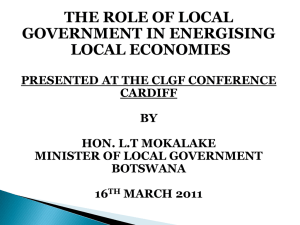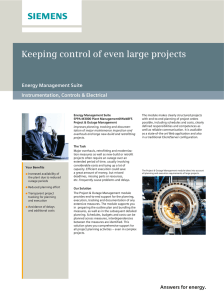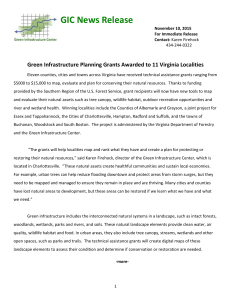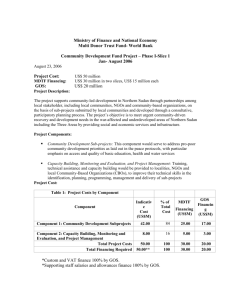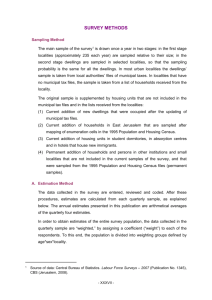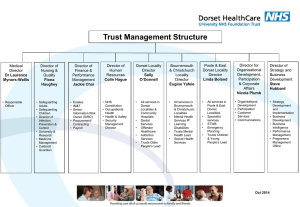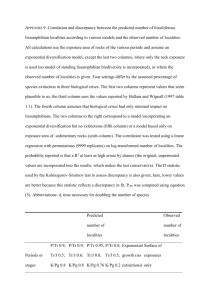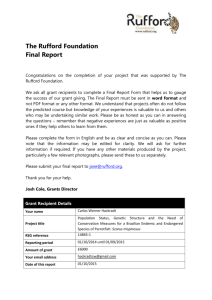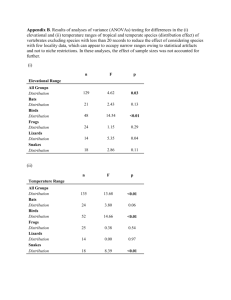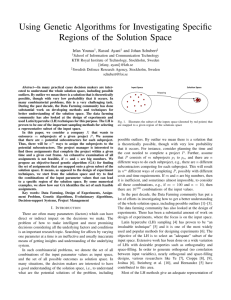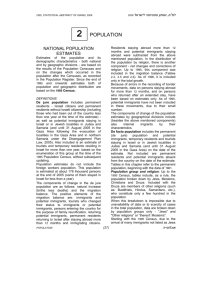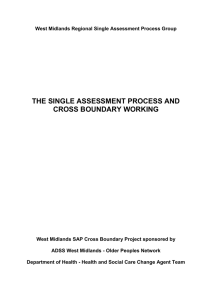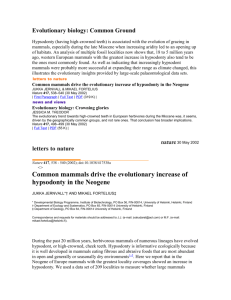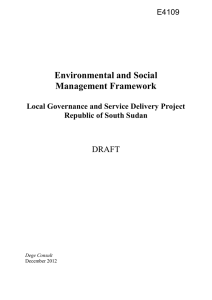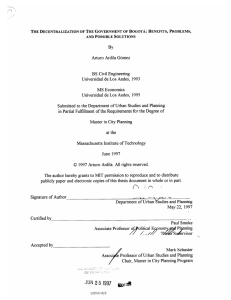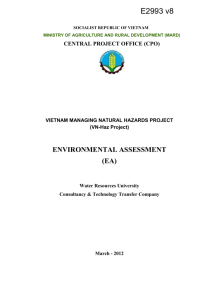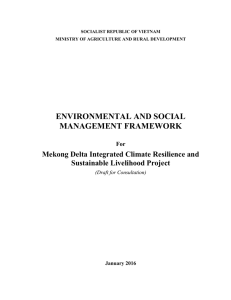project information document (pid) - Documents & Reports
advertisement
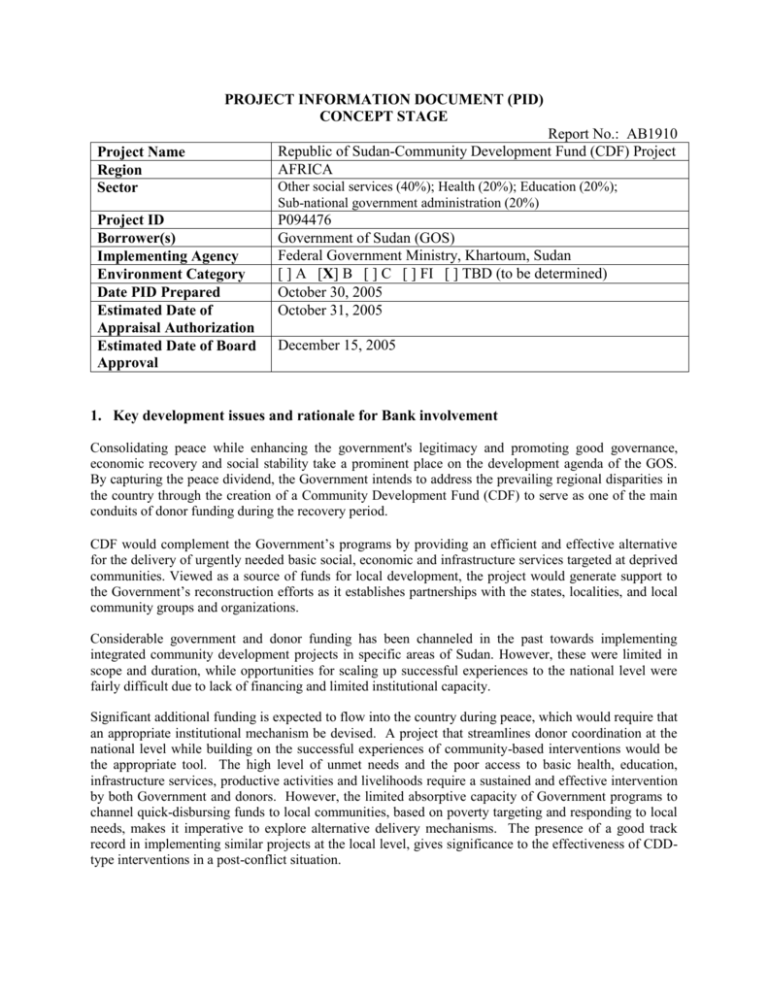
PROJECT INFORMATION DOCUMENT (PID) CONCEPT STAGE Project Name Region Sector Project ID Borrower(s) Implementing Agency Environment Category Date PID Prepared Estimated Date of Appraisal Authorization Estimated Date of Board Approval Report No.: AB1910 Republic of Sudan-Community Development Fund (CDF) Project AFRICA Other social services (40%); Health (20%); Education (20%); Sub-national government administration (20%) P094476 Government of Sudan (GOS) Federal Government Ministry, Khartoum, Sudan [ ] A [X] B [ ] C [ ] FI [ ] TBD (to be determined) October 30, 2005 October 31, 2005 December 15, 2005 1. Key development issues and rationale for Bank involvement Consolidating peace while enhancing the government's legitimacy and promoting good governance, economic recovery and social stability take a prominent place on the development agenda of the GOS. By capturing the peace dividend, the Government intends to address the prevailing regional disparities in the country through the creation of a Community Development Fund (CDF) to serve as one of the main conduits of donor funding during the recovery period. CDF would complement the Government’s programs by providing an efficient and effective alternative for the delivery of urgently needed basic social, economic and infrastructure services targeted at deprived communities. Viewed as a source of funds for local development, the project would generate support to the Government’s reconstruction efforts as it establishes partnerships with the states, localities, and local community groups and organizations. Considerable government and donor funding has been channeled in the past towards implementing integrated community development projects in specific areas of Sudan. However, these were limited in scope and duration, while opportunities for scaling up successful experiences to the national level were fairly difficult due to lack of financing and limited institutional capacity. Significant additional funding is expected to flow into the country during peace, which would require that an appropriate institutional mechanism be devised. A project that streamlines donor coordination at the national level while building on the successful experiences of community-based interventions would be the appropriate tool. The high level of unmet needs and the poor access to basic health, education, infrastructure services, productive activities and livelihoods require a sustained and effective intervention by both Government and donors. However, the limited absorptive capacity of Government programs to channel quick-disbursing funds to local communities, based on poverty targeting and responding to local needs, makes it imperative to explore alternative delivery mechanisms. The presence of a good track record in implementing similar projects at the local level, gives significance to the effectiveness of CDDtype interventions in a post-conflict situation. Rationale for Bank Involvement. The Bank has an extensive worldwide experience with similar social fund-type projects, which includes both success stories and failures. This experience shows that for operations to be successfully implemented, a number of factors need to be present. These factors include: a strong sense of commitment at the highest levels of the Government; a focused menu of interventions; a strong management with operational autonomy; transparent and detailed decision-making procedures with regular financial and operational audits; a demand-driven and simple community-based project design to ensure local ownership; an outreach program that emphasizes bottom-up initiatives; and a well established targeting and monitoring system. 2. Proposed objective(s) The objective of the Project is to meet urgent community-driven recovery and development needs in the war-affected and underdeveloped areas of North Sudan including the Three Areas by providing social and economic services and infrastructure. 3. Preliminary description Geographically, the Project will cover all Northern states and will coordinate closely with other major donor-funded community development projects (e.g. EU) to ensure harmonization of procedures and implementation mechanisms. The Project will be phased over several years and will consist of a series of successive three-year projects. Phase I (Years 1-3) will start in the following states: Blue Nile; Kassala, South Kordofan and North Kordofan. The Project will target ten localities selected according to urgent needs in these priority states. These are: o South Kordofan State: Abu Gebiha, AL Rashad and Kailak localities o North Kordofan State: Sodari, Jabrah and Wad Banda localities. o Blue Nile State: AL Roseries and ED’ Damazeen localities o Kassala State: Kassala rural and Hamaish Koraib localities. Project Components: Component 1. Community Development Subprojects This component would serve to address pro-poor community development priorities as laid out in the peace protocols, with particular emphasis on access and quality of basic education, health and water services. The component would target areas with low relevant per capita indicators and gender inequity to improve the access and, over time, quality of basic social services. It will build and renovate basic education and health facilities, promote adult literacy and child immunization campaigns, launch rapid vocational training programs for school-drop-outs, facilitate the creation of youth centers, launch revolving textbook projects and other social services directed at the poor. Programs to facilitate the social integration and inclusion of vulnerable groups such as elderly, disabled, women head of households and children victims of violence, AIDS victims, drug addicts, war-crippled victims, unemployed youths, etc., will also be emphasized. Gender and conflict-sensitive analysis will guide the allocation of resources among these vulnerable groups. This component would also concentrate on the provision of small rural infrastructure including access and rural roads and environmental protection activities including community potable water, wells and spring protection, small wastewater treatment schemes that use appropriate technologies, improved solid waste collection, treatment and disposal and reforestation and protection of natural sites. Communities and the organizations that represent them would take the lead in implementation under this window. Localities and other development partners, UN agencies and the private sector, would support communities in this process. This community-level window could also serve to support the return and reintegration process (particularly related to social services). The maximum size of a typical subproject under this component is $100,000 equivalent. All subproject proposals have to satisfy specific selection and eligibility criteria as stipulated in the project’s Operational Manual (OM). Component 2. Capacity Building, Monitoring and Evaluation, and Project Management Training, technical assistance and capacity building would be provided to localities, NGOs and local Community-Based Organizations (CBOs), to improve their technical skills in the identification, planning, programming, management and delivery of social subprojects. In addition, this component would establish the eligibility of target localities to receive funds from the project through conducting a training program aimed at building their capacity in the areas of project management (e.g., transparency, accountability, financial management, procurement), and community participation and empowerment (e.g., participatory planning process and inclusion of marginalized segments of the population in decisionmaking). Once the project validates the attainment by these localities of the above Minimum Qualifying Criteria (MQC), they will be eligible for receiving funds under the project, which they would then channel to service providers for the benefit of the target beneficiary communities using NGOs, CBOs, private sector, and social sector ministries. 4. Safeguard policies that might apply The project triggers OP 4.01 Environmental Assessment. The Community Development Subprojects component may have potential negative environmental impacts related to construction for improving and/or rehabilitating community social and economic infrastructure. Under this component, the project would finance the rehabilitation of schools, health and cultural facilities, community potable water supply, small wastewater disposal schemes, as well as irrigation and drainage schemes. Given the small scale of these community subprojects, negative environmental impacts that could arise would not be significant, irreversible or large in scale. Potential negative impacts will be mainly related to construction activities including disruption of traffic pattern, interference with other infrastructures, disrupted access to residential and/or other buildings, change in the landscape (loss of vegetation), noise nuisance, air pollution due to dust formation, safety hazard from construction activities and inappropriate disposal of excavated materials and construction debris. As is the case with other CDD projects, the OM will include procedures for appraising the environmental impacts of any proposed subproject. If a subproject is found to include substantial environmental impacts, further procedures are included to address them or to alter the design of the subproject. The OM will describe in detail how subprojects will be evaluated to ensure that environmental and social safeguards are enforced and World Bank policies are complied with. Environmental criteria will be included in the selection of subprojects, and adequate mitigation measures will be incorporated in the contract agreements so that all anticipated environmental impacts are avoided or minimized. 5. Tentative financing Source: GOS MDTF Total 6. Contact point Contact: Bassam Ramadan Title: Lead Operations Officer Tel: 5358 + 351 Fax: 251-11-662-77-00 Email: Bramadan@worldbank.org Location: Addis Ababa, Ethiopia 7. For information on other project related documents contact: The InfoShop The World Bank 1818 H Street, NW Washington, D.C. 20433 Telephone: (202) 458-5454 Fax: (202) 522-1500 Web: http:// www.worldbank.org/infoshop ($m.) 20 30 50

